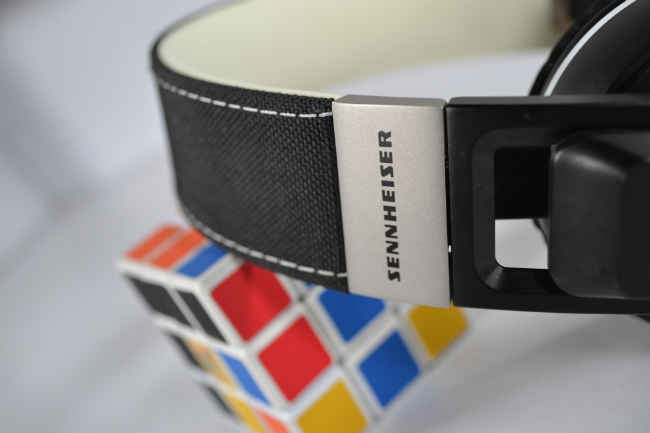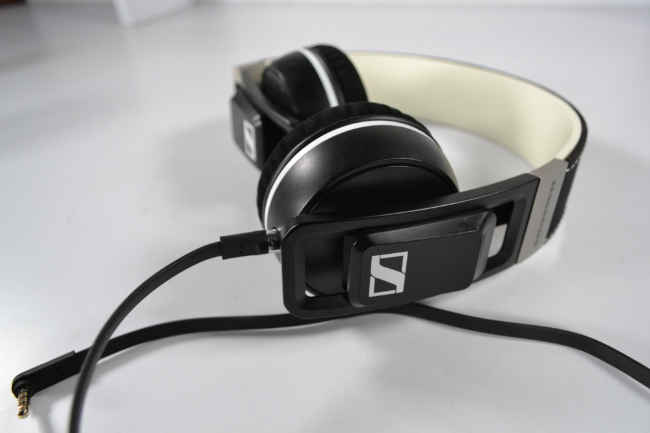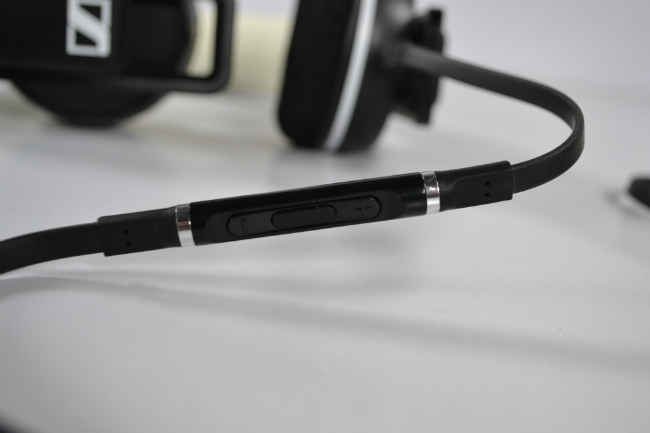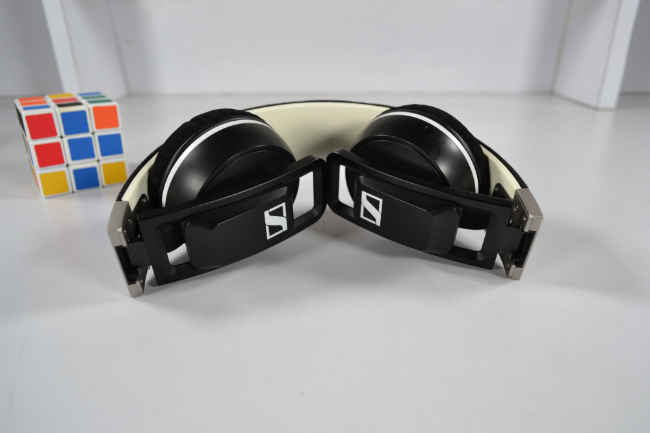Sennheiser Urbanite Review : All about that sound
The Sennheiser Urbanite is a masterpiece crafted by them geniuses at Sennheiser. Its audio delivery is a work of art, and if you are a music lover (which you are, if you are considering purchasing the Urbanite), it will delight you with every track you throw at it. The Urbanite played out the bass-ridden Rise by Flobots, Skrillex’s electronic mix Kyoto, Opeth’s prog-metal track Deliverance, Pink Floyd’s Great Gig in the Sky, and Stanley Jordan’s Stairway to Heaven two-handed melody tapping rendition, all sounding stellar. The only notable ‘flaw’ (if we can call it that) on the Urbanite is its weight. Additionally, circumaural headphones often tend to be more comfortable when it comes to prolonged usage (with the ear-covering cushions that we found in the Mi headphones). Being supra-aural, the Urbanite is not the most comfortable headphone. But, the audio quality makes up for me, and the durability of the premium build is an added beneficial factor. I reverberate my affection towards the Sennheiser Urbanite. Cheers to good audio!
The Urbanite is packed and presented to create favourable first impressions, but what lay beneath was the main attraction factor. Here’s looking at everything, in more detail.
BUILD and DESIGN
Sennheiser has left no stones unturned to present the Urbanite as the premium, urban pair of headsets that will appeal to the section of audio lovers who love their devices to look and feel premium, too. The head band, on the outer side, has black fabric material stitched in matrix pattern, with large, white stitches bordering both sides as inlays. Metal strips on either side precede the foldable plastic scopes that house the ear cups, adding to the premium touch. The only qualm that I had about the Urbanite’s build are the plastic guides and ear cups, made of matte plastic with a slight, shimmering finish. The plastic on the ears cups, especially, somewhat demeans the 16k price tag of the Urbanite. Sennheiser has done it to keep the headphone’s weight in check, but the Urbanite stills weighs in at a comparatively heavy 260 grams (only the Klipsch Status is heavier than the Urbanite, among its notable competitors).
The metal strip preceding the audio cups
The ear cushions are not interchangeable, and are not the most comfortable ones around. Despite the ample amount of buffer, I found the Urbanite rather overbearing on my ears, and the first time I played on the Urbanite, I was forced to take it off after 15-20mins of listening. Although I did get used to it after a while, it still isn’t the most comfortable pair of headphones around. When listening for more than 30-35mins, I’m still reminded that my pair of headphones is rather heavy. I was ready to sacrifice a little bit of comfort for the stellar audio quality, I had to take breathers every half an hour, to give fresh air to my ears.
You can adjust the Urbanite’s ear cups as per your convenience. The screws on the Urbanite’s metal strip looks sturdy, and hides the malleable rubber adjusters within. Adjusting the size is smooth, reiterating the fact that Sennheiser aimed at presenting the Urbanite as a complete experience, and not just a functional unit delivering good audio quality. Although I could not bring myself to like the plastic cup rails, the hinge that folds them in is quite sturdy, and there is no hint of creaks – only a distinct ‘click’ sound folding them in. Even after folding, the Urbanite is seven inches across in diameter (distance between the two hinges). Although it does fit neatly into the travel pouch, the Urbanite still feels too large. Not complaining, still.
The black plastic ear-cups did not really strike me
The wire, after more than a month’s rough usage, has showed no sign of wear and tear. It is tangle-free, the connecting jacks are well-designed, and the in-line audio controls and the microphone are convenient and easy to use. The microphone picks up audio well during calls, and the volume buttons have decent feedback. The buttons, however, feel a little congested, especially if you happen to have thicker fingers. Despite having slim fingers, I ended up clicking on the call button, repeatedly launching iTunes on the Mac, when all that I intended to do was change the volume. A slight, ergonomic glitch, but you will hopefully get used to the key placement. I’m still trying to.
The wire interlocks neatly with the Left ear cup. Sennheiser has used a 2.5mm audio connector for the headphone-end. This ensures that you will not be using the wire with any other speaker around. The interlocking mechanism here is a neat addition, ensuring that your headphone does not get disconnected by mistake. The wire, overall, feels quite durable and strong enough to withstand a few hefty tugs in crowded public transit services.
The Urbanite's in-line controls
Overall, in terms of build quality and design, the Sennheiser Urbanite is a classy audio unit. Despite the plastic rails, audio cups, large size and the heavy weight, the Urbanite looks like a pair of headphones that has been built with ‘premium’ outlook from day one, and sets up the tone for a powerful, competent audio device.
FEATURES and SPECIFICATIONS
Specifications-wise, here’s how the Sennheiser Urbanite loads up:
|
Type |
Supra-aural |
|
Frequency Range |
16-22000Hz |
|
Mic Frequency Range |
100-10000Hz |
|
Weight |
260g |
|
Microphone |
Omni-directional |
|
Wire Length |
1.2m |
|
Impedance |
18Ω |
|
Sound Pressure Level |
118dB |
The Urbanite does not offer any wireless connectivity options with this pair of headphones, and you will need to opt for the more expensive Urbanite XL for wireless features. Features-wise, the Sennheiser Urbanite packs in an impedance of 18Ω – a crucial peg that makes it stand out. The low impedance of the Urbanite aids the low power input of smartphones, to provide clear audio output at high volume levels. Made for iPhones and iPads, the Urbanite is optimized for amplifying low power audio signals. Despite the supra-aural ear coupling, the Urbanite delivers excellent noise attenuation, thanks to its deep, absorbent cushions. The frequency range of 16Hz to 22kHz covers the entire sonic range, while the 100Hz to 10kHz frequency range of the omni-directional microphone cuts out much of the ambient noise, to capture better incident audio during calls. As part of other features, the Urbanite has a high Sound Pressure Level (SPL) of 118dB. A headphone’s SPL is measured by playing an audio note of 1kHz frequency at sound pressure of 1Vrms (Volt root mean square). The 118dB SPL is high enough to account for distinct, loud audio. The Urbanite carries a THD (Total Harmonic Distortion) rating of less than 0.5%, which is good. Professional headphones carry a THD rating of less than 0.1%, while ‘premium’ smartphone-oriented headphones have THD ratings of less than 1%. A headphone’s THD rating is the amount of irregular vibrations that its diaphragm goes through, and hence, creates what is commonly known as ‘audio distortion’. The Urbanite employs closed dynamic transducer principle, which is often the most-used in headphones within the lower budget spectrum in comparison to their more expensive counterparts. This is particularly beneficial, as it is more cost-effective than electrostatic transducers, uses loudspeaker-like robust mechanisms, and provides high fidelity audio. To sum up its features, the Sennheiser Urbanite is well equipped to provide loud, clean audio by optimizing its required input power.
The detachable wire and foldability aids the Urbanite's large size
In terms of usability, the Urbanite comes with a detachable connecting wire and foldable ear cups, which make carrying it around convenient. Additionally, the in-line controls make it a complete smartphone package. Although the absence of parallel wireless connectivity in this version of the Urbanite might seem like a deterrent to a few, especially for the 16k price tag, it did not seem that way to me, because I still find wired connectivity more trustworthy and did not need to worry about any battery issues with the headphone (don’t we have enough of that with our phones, anyway?). Plus, for the audio quality that the Urbanite provides, the lack of wireless controls and connectivity barely bothered me, ever. If you are still intent on getting the same unit with wireless connectivity, you can go for the top-of-the-line member of the Urbanite family, the Sennheiser Urbanite XL Wireless. But, you will be required to shell out another 9k for the added convenience, as the Urbanite XL Wireless is priced at Rs. 24,990. Personally, the tangle-free 1.2m detachable wire does more than enough to please my auditory cravings.
PERFORMANCE
Before talking about how the Sennheiser Urbanite performed, here’s looking at the tracks that I’ve focused on while rating the Urbanite’s performance:
– Deliverance (Opeth)
– The Great Gig in the Sky (Pink Floyd)
– Rise (Flobots)
– Kyoto (Skrillex)
– Equinox (John Coltrane)
– Crossroads (Cream)
– Stairway to Heaven: Cover (Stanley Jordan)
– Lux Aeterna (Clint Mansell)
– Flying in a Blue Dream: Live at G3 (Joe Satriani)
For most of this review till now, I have spoken about the Urbanite’s cosmetic details and on-sheet specifications and how they theoretically translate in terms of the headphone’s rating. It is here, that the Urbanite means sheer business, and it is hard to stop praising the Urbanite’s audio prowess, and its maker Sennheiser’s supremacy in the audio industry. The Urbanite delivers every inch of what it promises to, on paper. While the audio soundstage is not as supreme as you would come to expect in open-ear headphones (that almost always provide a ‘complete’ soundstage), the Urbanite’s balanced compactness of the audio makes for a lateral audioscape, without compromising on the complete array. The bassline is distinct, with every distinct bass note hitting you behind the entire range of higher frequencies. At the same time, it does not overbear, or hover above the sharper notes. The Urbanite is rich in bass, but balances it to not overpower the audio and make it bass-ridden.
The higher notes are equally sharp, but does not hurt the ear. For instance, while listening to Opeth’s Deliverance, the audio notes hit you with the direct aggression that the track carries. The mid-range frequencies have no flat annotations, and the high gain levels are reflected in the distortion patch applied on the guitar tune. The progressive metal track’s hi-hats come through clearly, and there is practically not a single aspect that the Urbanite loses out on. Listening to John Coltrane’s tenor saxophone playing Equinox on the C# minor scale brings through the perfect, swing feel of the American jazz standard. The double bass is ample, and the echo on the toms, the bass drum and the snare rolls are pristine. You can almost visualise the drumsticks on the crash ride cymbal as the track closes – heaven for every jazz lover out there. Switching gears to Pink Floyd’s soaring, Great Gig in the Sky, the Urbanite layers Wright’s piano progression on top of Clare Torry’s orgasmic vocals – that fantastic voice, as Wright described it. While Torry’s vocals, at first, may sound slightly subdued, the audio binds together, enforcing higher mids in a track that would otherwise sound piercingly high in Torry’s high pitched squeal. Waters’ bassline is a steady backbone to the track. The Urbanite, in short, presents the tracks the way they would sound best – balanced, pristine, and yet carrying the crunch that livened every track that I played on my iPhone. Nothing short of brilliant.
The Urbanite's glowing audio quality is a brilliant experience
The Urbanite made most of its money and won me over with its balance of audio performance. The bass frequencies are neither overpowering, nor subdued. The mids have no threat of sounding flat, and the highs do not pierce. And yet, the low impedance amplifies the audio signal to present a high volume level. While the supra-aural build may seem to some as a sign of lower noise cancellation capability, putting the Urbanite on by itself blocks out a huge section of ambient noise, and there is almost absolutely no ambient noise when you are listening to something. Complete isolation, and that’s how I loved my days with the Urbanite.
It’s hard to not love the Urbanite’s sound, especially when you’re listening to Satriani’s whammies in Flying in a Blue Dream, or David Gilmour’s lap steel crying the ending solo of High Hopes. There were no out-of-place distortion in any track whatsoever, and I threw a number of effects to the Urbanite – ranging from flangers, wahs and heavy distortion patches, with each sounding as authentic and true-to-ear as ever. The true-to-ear audio performance was taken in comparison to the direct incident sound inside a studio equipped with M-Audio professional audio setup, and a home setup with M-Audio BX-8 D2 monitors. Tracks along with the effect patches were played on a Schecter Damien Elite-7 FR guitar, with patches processed through a Boss GT-100 floorboard guitar effects processor. Keyboard/piano effects were played on a Korg Kronos keyboard. All of these were live tracks played, recorded on an iMac used for home audio production, and played on an iPhone. The Sony MDR-7520 does provide comparatively better audio delivery than the Urbanite (the Sony’s low impedance of 24Ω does make it suitable for mobile audio, and the 5-80kHz is a formidable audio range on offer), you will not be opting for it unless you are personally producing audio at a professional/semi-professional level, and have a much higher price tag at Rs. 33,990 ($499.99 in U.S.). Specifications-wise, it also wins over the Klipsch Status, which features a higher impedance level, marginally higher frequency range, lower sensitivity level, and a higher price tag (Rs. 22,900). The Sennheiser Urbanite is sheer brilliance, and it delivers worth every penny of the Rs. 15,999 price tag.
BOTTOMLINE
The Sennheiser Urbanite is a masterpiece crafted by them geniuses at Sennheiser. Its audio delivery is a work of art, and if you are a music lover (which you are, if you are considering purchasing the Urbanite), it will delight you with every track you throw at it. The Urbanite played out the bass-ridden Rise by Flobots, Skrillex’s electronic mix Kyoto, Opeth’s prog-metal track Deliverance, Pink Floyd’s Great Gig in the Sky, and Stanley Jordan’s Stairway to Heaven two-handed melody tapping rendition, all sounding stellar. The only notable ‘flaw’ (if we can call it that) on the Urbanite is its weight. Additionally, circumaural headphones often tend to be more comfortable when it comes to prolonged usage (with the ear-covering cushions that we found in the Mi headphones). Being supra-aural, the Urbanite is not the most comfortable headphone. But, the audio quality makes up for me, and the durability of the premium build is an added beneficial factor. I reverberate my affection towards the Sennheiser Urbanite. Cheers to good audio!





